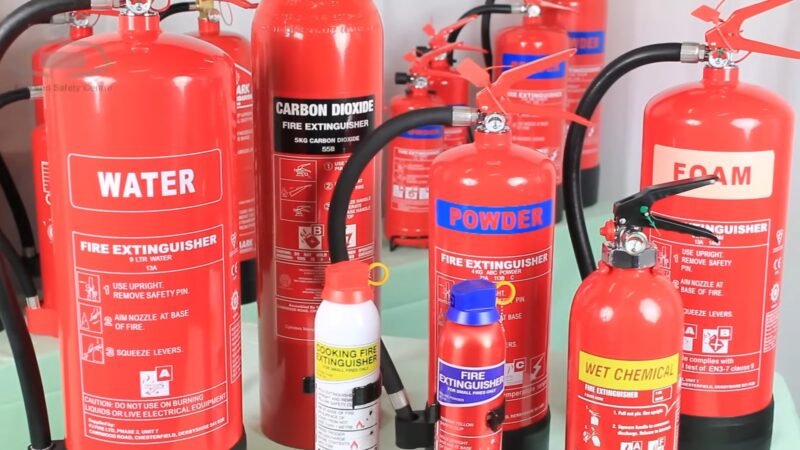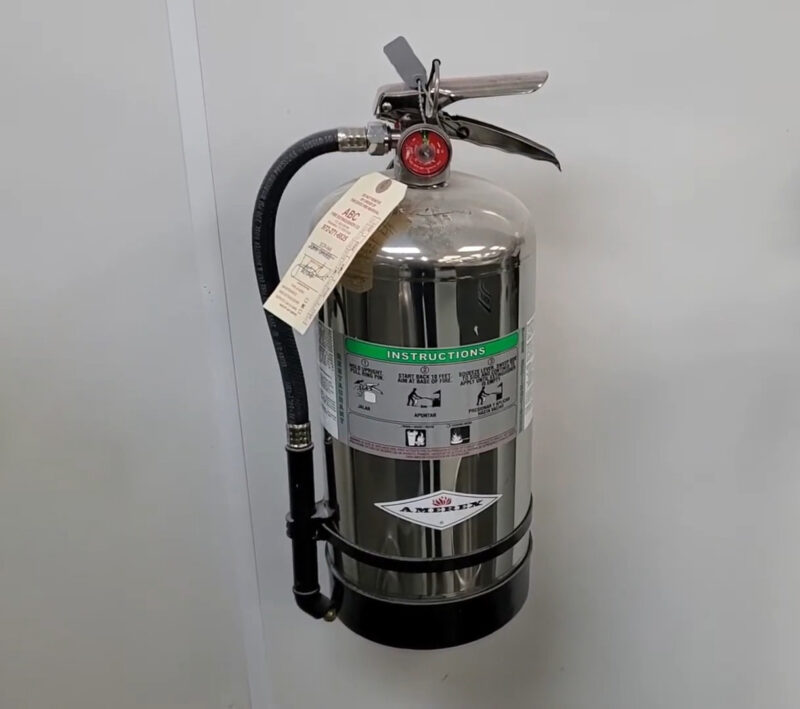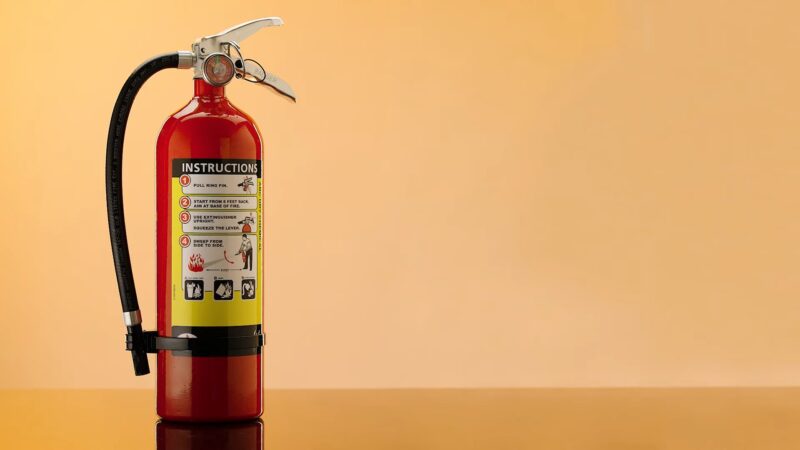Fire extinguishers are a vital component in fire safety and prevention, with specific types designed for various kinds of fires. In kitchens, fire risks are omnipresent, thanks to the myriad of cooking appliances and the presence of flammable materials like oil and paper.
Knowing which one to use is crucial in mitigating damage and ensuring safety. In this piece, we will discuss the world of fire extinguishers, unraveling which are most commonly found in kitchens and why.
Classes Explained

Understanding the different classes of fire extinguishers is crucial for making an informed decision about which type to install in a kitchen. Each class is designed to combat different kinds of fires, with their efficacy depending on the materials that are burning.
Class A
Class A fire extinguishers are the most common type of fire extinguisher, ideal for ordinary combustibles like wood and paper. These are not the most suitable for kitchen fires as they are not designed to combat fires involving cooking fats and oils.
- Suitability: Class A extinguishers are suitable for ordinary materials like wood, cloth, and paper, usually found in various areas around a home or an office, rather than in kitchens.
- Working Mechanism: They utilize water or foam to cool the burning material below its ignition point, effectively suppressing the fire.
Class B
Class B extinguishers are designed to combat flammable liquid fires, such as those involving gasoline or oil. These can be more suitable for kitchens, especially in scenarios where oils and fats are involved.
- Suitability: Class B units are suitable for flammable liquids and gas fires, making them apt for garage or kitchen fires, especially those involving cooking oils and fats.
- Working Mechanism: These work by creating a barrier between the fuel and oxygen, thereby starving the fire and extinguishing it.
The Prevalence of Class K in Kitchens

In many kitchens, particularly commercial ones, Class K fire extinguishers are prevalent. These extinguishers are specifically designed for high-efficiency cooking appliances and the types of fires that can arise therein, making them a pivotal component for kitchen fire safety.
Features of Class K
Class K fire extinguishers are specialized units that are created to address fires involving cooking oils and fats. They are a staple in commercial kitchens but are becoming increasingly common in household kitchens due to the rise of high-efficiency cooking appliances.
- Specialized Application: Class K units are specifically designed for kitchen fires, especially those involving cooking oils and fats, which are typically of high temperature and can be extremely dangerous.
- Working Mechanism: These use a wet chemical agent that reacts with the burning oil or fat to create a foam, suppressing the fire and preventing re-ignition by cooling the burning material and preventing contact with oxygen.
Importance of Class K in Commercial Kitchens
Given the nature of commercial kitchens, where large volumes of cooking oils and high temperatures are prevalent, having Class K extinguishers is crucial. These ensure safety and are tailored to combat the kind of fires that are most likely to occur in such settings.
- Tailored for High Risk: Commercial kitchens are high-risk environments due to the high volumes of cooking oils and the temperatures involved. Class K extinguishers are tailored to mitigate this risk, providing effective fire suppression.
- Regulatory Compliance: Many regions mandate the presence of Class K extinguishers in commercial kitchens as part of regulatory compliance, emphasizing their importance in maintaining safety standards.
The Residential Kitchen: Class C and Class K

For residential kitchens, both Class C and Class K extinguishers are recommended. While Class K ones deal with high-efficiency cooking appliances and oil and fat fires, Class C ones are designed to handle electrical fires, which can also occur in kitchens due to the abundance of electrical appliances.
Why Choose Class C
Class C extinguishers are suitable for electrical fires, making them an essential safety component in kitchens where appliances like microwaves, ovens, and refrigerators are in use. The absence of a conductive agent makes them safe for such fires.
- Non-Conductive Agent: Class C units use a non-conductive extinguishing agent, making them safe for combating fires involving electrical equipment without risking electrocution.
- Suitability: Given the number of electrical appliances in modern kitchens, having a Class C unit can provide a level of safety against potential electrical fires that may arise.
Class K for Modern Household Kitchens
With the advent of high-efficiency cooking appliances in household kitchens, the need for Class K extinguishers in residential settings has become more pronounced. They offer an added layer of safety, especially during the preparation of dishes involving cooking oils and fats.
- Adaptation to Modern Cooking: Modern cooking techniques and appliances pose new risks, necessitating the presence of extinguishers that are capable of addressing high-temperature oil and fat fires.
- Enhanced Safety Measures: The presence of a Class K unit, in addition to a Class C one, ensures a comprehensive approach to fire safety in kitchens, addressing various types of fires that can occur.
Selecting the Appropriate One
When it comes to selecting the appropriate fire extinguisher for a kitchen, considering the types of fire risks involved is essential. It’s crucial to understand the features, functionalities, and applications of various fire extinguishers to make the right choice for kitchen safety.
Assessing Fire Risks in Kitchens
Before selecting a fire extinguisher, it’s vital to assess the types of fire risks present in a kitchen. Both residential and commercial kitchens have varied fire risks, depending on the cooking methods and appliances in use.
- Identifying Potential Hazards: Evaluate the kitchen environment to identify potential fire hazards, like flammable liquids, cooking oils, and electrical appliances, and choose a fire extinguisher that can effectively combat these specific risks.
- Analyzing Cooking Methods: The cooking methods used, whether they involve high-heat oils or electric appliances, can determine the types of fire risks present and, consequently, the type of fire extinguisher needed.
Multi-Class Extinguishers for Comprehensive Safety
Sometimes, using multi-class extinguishers can offer a more comprehensive approach to fire safety in kitchens. These are versatile and designed to combat different types of fires, providing a one-stop solution.
- Versatility and Coverage: Multi-class extinguishers, like ABC ones, can handle various types of fires, making them a versatile choice for those looking for wide-ranging coverage in kitchen environments.
- Convenience and Accessibility: Having a multi-class extinguisher ensures that you have the right tool at your disposal, irrespective of the fire type, offering convenience and enhancing safety levels.
Installation and Accessibility
Having the right fire extinguisher is one thing; ensuring it’s properly installed and easily accessible is another. Proper installation and accessibility are crucial components of effective fire safety in kitchens.
Proper Installation Techniques
Installing a fire extinguisher properly is crucial to ensure it’s functional and accessible during emergencies. The installation should comply with the guidelines provided by the manufacturer and local fire safety regulations.
- Compliance and Guidelines: Adhere to the installation guidelines provided with the extinguisher and ensure compliance with local fire safety norms to optimize the effectiveness of the fire extinguisher.
- Visibility and Reach: Install it where it is easily visible and reachable, avoiding any obstructions, and ensuring quick access during a fire emergency.
Regular Maintenance and Inspection
Regular inspection and maintenance are vital to ensure the fire extinguisher is in working condition. It involves checking the pressure levels, ensuring there are no obstructions in the nozzle, and having it serviced regularly by professionals.
- Scheduled Inspections: Regularly inspect the extinguisher to ensure it is charged and operational, adhering to a consistent schedule to avoid any lapses in safety preparedness.
- Professional Servicing: Have the extinguisher professionally serviced at regular intervals, checking for any damages or issues that might impede its functionality during a fire emergency.
Educating Kitchen Users
While having the right type of fire extinguisher installed is essential, educating the users of the kitchen on how to use one is equally important. A well-informed and trained individual can effectively use it to control a fire before it escalates.
Importance of Fire Safety Training
Training kitchen users, whether it’s in a household or a commercial setting, enhances the overall safety levels. People who are trained are more likely to respond promptly and effectively in case of a fire emergency.
- Prompt Response: Training empowers individuals to respond quickly and effectively, reducing the response time and mitigating damage in the event of a fire.
- Enhanced Safety Levels: Knowledgeable and trained individuals contribute to a safer kitchen environment, minimizing risks and ensuring appropriate actions are taken during fire emergencies.
Conducting Regular Drills
Conducting regular fire safety drills is another method to ensure that the kitchen users are well-acquainted with the steps to be taken during a fire. These drills simulate real-life scenarios, helping individuals to practice and prepare for actual emergencies.
- Real-life Simulation: Regular drills simulate actual fire scenarios, allowing individuals to practice using fire extinguishers and familiarizing them with evacuation routes, ensuring preparedness.
- Confidence Building: Familiarity with fire safety procedures and regular practice builds confidence among kitchen users, enabling them to handle real-life fire emergencies more effectively.
FAQs
Can a Class K fire extinguisher be used on electrical fires in the kitchen?
No, Class K units are specifically designed for kitchen fires involving cooking oils and fats, and they are not suitable for electrical fires. For electrical fires, a Class C one, which is designed to combat fires involving energized electrical equipment, would be more suitable.
Are water mist extinguishers suitable for kitchen fires?
These can be suitable for some kitchen fires as they use deionized water and are safe to use on Class A and C fires. However, they should not be used on fires involving cooking oils and fats, as water can cause such fires to spread. For these fires, a Class K extinguisher would be more appropriate.
How often should kitchen fire extinguishers be inspected or maintained?
It’s recommended that fire extinguishers be inspected at least once a month for any signs of damage or tampering and undergo maintenance annually by a qualified professional to ensure they are in proper working condition.
Do all commercial kitchens require a Class K fire extinguisher?
While it is highly recommended due to the specialized nature of Class K extinguishers in dealing with kitchen fires involving cooking oils and fats, specific requirements can vary depending on local fire codes and regulations. Always refer to these local requirements to ensure full compliance.
Is there any indicator to know if the fire extinguisher is fully charged and operational?
Yes, most of them have a pressure gauge that indicates whether the extinguisher is fully charged, overcharged, or undercharged. A fully charged one will have the needle in the green zone. Additionally, the extinguisher should have a safety seal intact, indicating it has not been used.
Can I use a Class A fire extinguisher if I don’t have a Class K available during a kitchen fire?
Using a Class A fire extinguisher on a kitchen fire, especially one involving cooking oils and fats can be very dangerous, as Class A ones typically use water or water-based agents, which can cause a grease fire to spread.
It’s crucial to use a fire extinguisher that is suitable for the specific type of fire involved. In the absence of a Class K one, a multipurpose ABC or BC extinguisher could be used as a substitute.
Final Words
Identifying the right fire extinguisher for kitchens is of paramount importance, especially considering the diverse fire risks present in such an environment. Whether it’s a commercial or a residential kitchen, ensuring that the appropriate fire extinguisher is accessible can make a significant difference in mitigating damage and ensuring the safety of the inhabitants.
While Class K extinguishers are not traditionally viewed as necessary kitchen tools, they have gained significant recognition in modern household kitchens due to their increasing importance in ensuring fire safety. As a result, they have become a vital component of fire safety measures in kitchens of all types.

